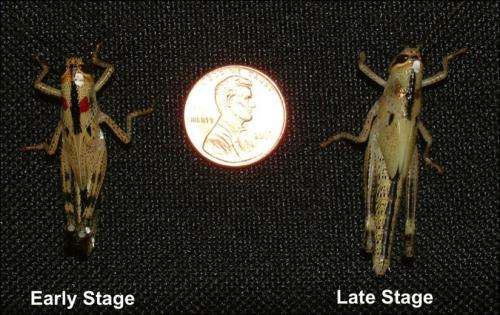Less oxygen triggers grasshopper molting, farmers could benefit

Less oxygen = shorter time between molts = shorter life-span = fewer hungry grasshoppers. And for farmers, that's very good news. A recent study conducted by Scott Kirkton, associate professor of biology at Union College, offers insight into the relationship between respiratory function and molting that could help farmers save more of their crops.
"These grasshoppers, Schistocerca americana, emerge as 10-milligram juveniles and become 2.5-gram adults in about six weeks," Kirkton said. "That's a 250-fold weight increase - the equivalent of an 8-pound baby being 2,000 pounds after six weeks."
With each molt, grasshoppers shed their exoskeletons and emerge into new ones that provide room for growth. During the six stages of their lifecycle, they get progressively larger.
Using an x-ray video or synchrotron at Argonne National Laboratory's Advanced Photon Source in Chicago, Kirkton and his collaborator, Kendra Greenlee, assistant professor of biology at North Dakota State University, visualized living grasshoppers at different stages within an instar – the time between molts. They found that grasshoppers' insides are essentially too big for their outsides near the end of each stage, and organs for breathing (air sacs and tracheae) were compressed.
"We found that late-stage grasshoppers have trouble breathing and oxygen delivery is reduced, such that molting might occur sooner than expected to increase exoskeleton size and alleviate respiratory system compression," said Kirkton.
And if oxygen availability does trigger molting, farmers could benefit.
"If crops were stored at lower oxygen levels, we might be able to reduce the effect of pests," said Kirkton. "Less oxygen would decrease body size by forcing pests to complete life-stages faster, giving them less time to reach maximum adult size. Also, low oxygen may reduce metabolism, and therefore, insect appetite."
Provided by Union College















